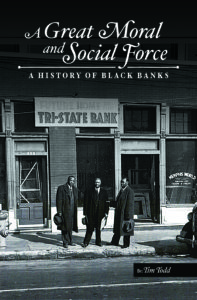 Join Tim Todd for a free virtual conversation on his new book A GREAT MORAL AND SOCIAL FORCE: A History of Black Banks.
Join Tim Todd for a free virtual conversation on his new book A GREAT MORAL AND SOCIAL FORCE: A History of Black Banks.
Through recent historic films that explore the events leading up to the 1921 massacre in Tulsa’s Greenwood District, millions of Americans learned for the first time about this chapter in the nation’s history, and about once thriving Black-owned communities, businesses, and banks.
But Tulsa’s Greenwood District, dubbed “Black Wall Street” by Booker T. Washington, wasn’t the only center of Black commerce in America. A forthcoming book from the Federal Reserve Bank of Kansas City brings additional context to the economic history of underrepresented communities in the United States, reaffirms the significance of Black economic enclaves, and serves as a resource for communities attempting to obtain financial success under challenging circumstances.
Black banks that were established in the late 19th and early 20th centuries provided financial hubs at pivotal points in history in Richmond, VA; Boley, OK; Chicago, IL; Memphis, TN; and Detroit, MI, among others. Unfortunately, many Americans are unaware of these stories of Black economic empowerment, and the challenges Black banks in the South and Midwest faced remain largely unknown.

In the Bank’s new book, A GREAT MORAL AND SOCIAL FORCE: A History of Black Banks (Timothy Todd; Pub Date: January 11, 2022; Price: Free Publication; ISBN: 978-0-9744809-6-1; Pages 280), writer Tim Todd focuses on the story of these cities, which were each shining examples of Black wealth and success. The book also explores factors that contributed to the demise of Black banks at the peak of their success and provides historical context and analysis about why the dismantling of Black banks has played a central role in the hurdles many BIPOC people face today regarding financial security and amassing generational wealth.
Rather than presenting a comprehensive history of Black banking, the goal of A Great Moral and Social Forceis to move across eras and examine some of the communities where banks played a dual role in establishing both economic opportunity and social equality. These banks were not purely a financial endeavor or a business opportunity but more importantly, were created with the primary mission of public service in mind. Community banks were catalysts in helping families and individuals establish businesses, buy homes, and pay for an education that could open the door to opportunity. In their role as pillars of the community, Black banks were involved in some of the most important race relations events in American history and during the struggle for civil rights, Black bankers were among the leaders in the Black community who spearheaded the fight for social justice.

